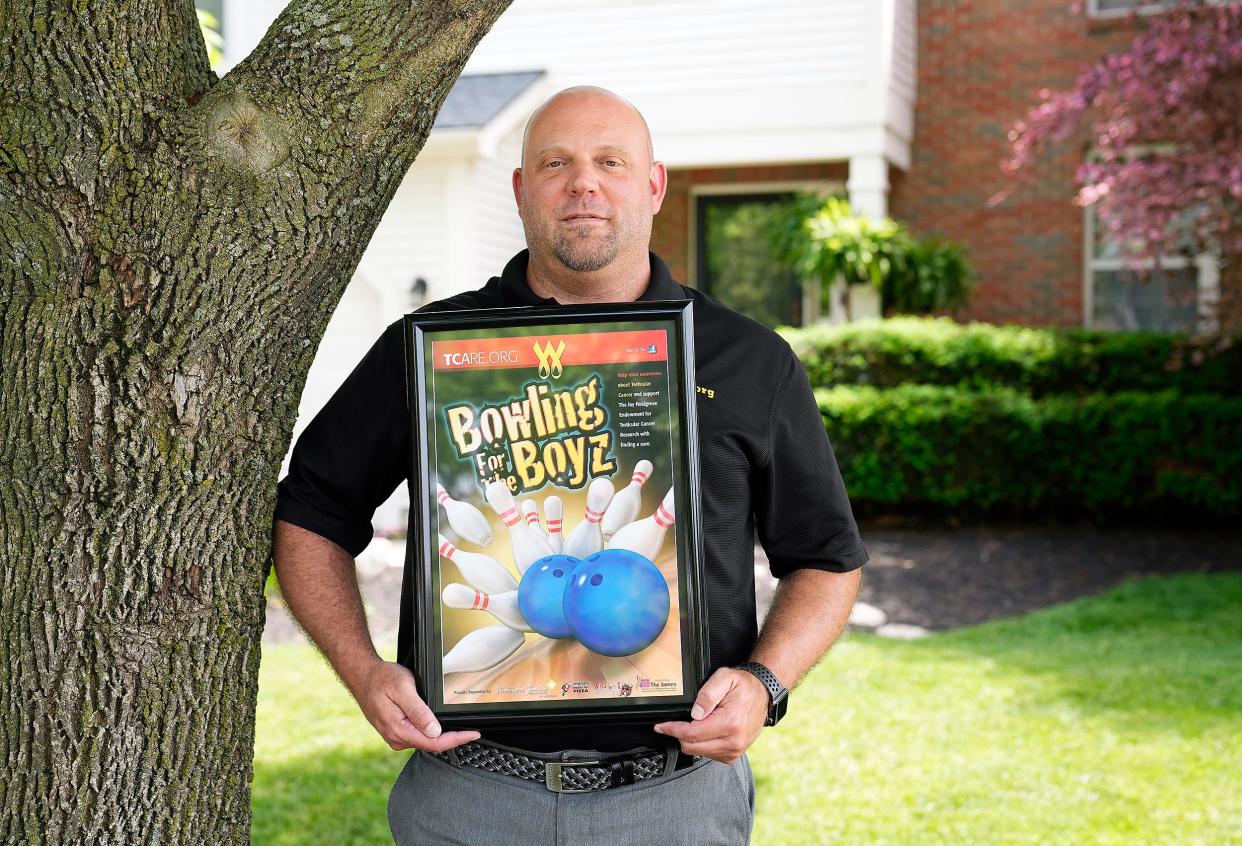'Pay it forward': One testicular cancer survivor raises funds for research

A self-proclaimed lifelong Buckeye, Jay Holdgreve has always tried to live by former Ohio State University football coach Woody Hayes' famous saying: “You can never pay back, but you can always pay forward.”
But it wasn’t until after Holdgreve was diagnosed with testicular cancer at the age of 34 in 2010 that he came to fully understand the meaning of that statement.
In 2011, Holdgreve, an Ohio State alum from Dublin, established an endowment that has since raised more than $146,000 for testicular cancer research at the university's James Cancer Hospital.
Testicular cancer affects about 1 in 250 men during their lifetimes, and it is the most common cancer affecting men ages 15 to 35, according to the Cleveland Clinic.
After receiving the diagnosis in 2010, the reality of his illness hit Holdgreve first.
“I didn't know anybody who had cancer and survived — that was my first thought,” he said. “I had three little kids, and was like, ‘We’re going to beat this and go from here.’”
Luckily, testicular cancer is extremely treatable, and the most common treatment is simply to remove the affected testicle, said Ben Martin, a urologist with the Mount Carmel Health System.
“That part of the operation is not that big of a deal,” Martin said.
'Coping is hard.' Ohio State cancer doctor's own diagnosis helps him relate to his patients
The situation with Holdgreve's testicular cancer ended up being less severe than the initial diagnosis. However, Holdgreve still had to get surgery to remove his right testicle in 2010.
Testicular cancer: Fighting the stigma
Holdgreve, who is now 45, said he had never heard people talk about testicular cancer before his own battle with it, and he didn't know anyone who had dealt with the disease. So when he got his diagnosis, Holdgrove knew he wanted to increase awareness about the condition, which affects 8,000 to 10,000 men a year.
“I was thinking I didn't have any recollection about being talked to in junior high, high school or even the college level (about testicular cancer),” he said.
Shawn Dason, a urologic oncologist with Ohio State's Comprehensive Cancer Center, is often the first person someone with suspected testicular cancer sees in their cancer treatment. Many young men have a hard time understanding how they got a cancer diagnosis at such a young age, he said.
“Hearing the big ‘C’ word at that age is really tough for people,” Dason said. “It's usually a huge shock and stress for them."
Martin said some young men take the news badly because they don't have a lot of experience dealing with medical issues yet.
Holdgreve said there also remains a stigma around sexual health, and men often put off going to the doctor even when they know they should be seen.
“I probably waited longer than I should have," he said.
Cancer treatments: Ohio's late-stage cancer patients no longer have to 'fail first' on less effective treatment
Martin pointed to American cyclist Lance Armstrong’s battle with cancer as an example of how men may put off seeking treatment for cancer or other potentially life-threatening illnesses. In 1996, at the age of 25, Armstrong was diagnosed with stage three testicular cancer, which had spread to his lymph nodes, lungs, brain and abdomen.
“He is a classic example, he really thought he was a tough young guy and he waited until he could literally not ride his bike,” Martin said of what some call a "warrior mentality" to push through adversity.
Armstrong eventually was successfully treated for testicular cancer in 1997 and in the same year established the Lance Armstrong Foundation, later called Livestrong, to support cancer awareness and research.
Holdgreve said Armstrong’s Livestrong campaign and “no shave November,” a month when people don’t shave to raise awareness for men’s health, have been crucial for bringing testicular cancer into public awareness.
“That’s been great not only for men’s testicular cancer but also mental health for men,” Holdgreve said.
Testicular cancer: What are the signs? What is the outlook?
Dason encourages young men, especially those with a family history of cancer, to routinely examine their testicles for changes.
Early detection is crucial, Dason said.
“You definitely don't want to mess around with it," Dason said. "Oftentimes the less intensive treatment is required (with earlier detection)."
Fifty years ago, a diagnosis of metastatic testicular cancer meant a 90% mortality rate within one year with little chance for treatment, according to the Journal of Clinical Oncology. Today, the average survival rate among all types of testicular cancer is 95%, according to the American Cancer Society.
Testicular cancer was among the first for which chemotherapy was proven as an effective treatment, Martin said.
Outcomes for testicular cancer patients are getting even better in recent years and a “surge of new treatments” will continue to increase the survivability of the disease, Dason said.
“More men are surviving — that was not something that was the case 50 years ago,” Dason said.
With the exception of 2020 and 2021 because of the COVID-19 pandemic, Holdgreve has organized an annual testicular cancer research Bowling with the Boyz fundraiser in his hometown of Delphos in western Ohio.
He began with an initial goal of raising $50,000 for the endowment fund over five years. But he ended up accomplishing that in just two years.
Holdgreve hopes his story will help others suffering from testicular cancer and believes the research coming out of OSU's James Cancer Hospital will continue to be “game-changing.”
“There is no way I can ever repay that back," Holdgreve said of his treatment at the James. "I can only continue to pay it forward.”
Cole Behrens is a reporter at The Columbus Dispatch covering public safety and breaking news. You can reach him at CBehrens@dispatch.com or find him on Twitter at @Colebehr_report.
This article originally appeared on The Columbus Dispatch: Testicular cancer survivor raises funds for OSU James Hospital

